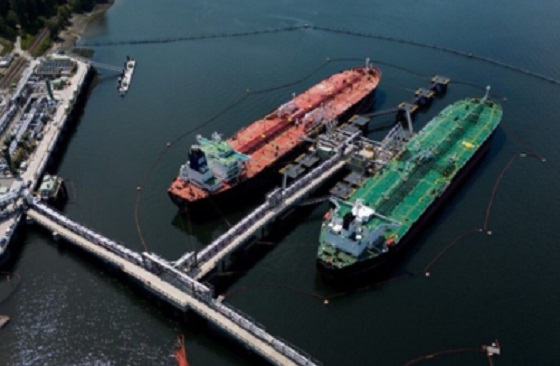Energy
Energy, climate, and economics — A smarter path for Canada

By Resource Works senior fellow Jerome Gessaroli
Canada has set ambitious climate goals, aiming to cut its greenhouse-gas emissions by 40 to 45 per cent by 2030, and to hit net-zero emissions by 2050.
Now a senior fellow at Resource Works, Jerome Gessaroli, argues that Canada is over-focusing internally on reducing greenhouse-gas emissions, when we should “look at cooperating with developing countries to jointly reduce emissions.”
He continues: “And we do that in a way that helps ourselves. It helps meet our own goals. That’s through Article 6 of the Paris Accord, allowing countries to share emission reduction credits from jointly developed projects.”
Reduction on a global scale
Article 6, says Gessaroli, means this: “We can work towards meeting our own emission goals, and can help developing countries meet theirs. We can do it in a way that’s much more efficient. We get a lot more bang for our buck than if we are trying to just do it domestically on our own.”
The point is that, in the end, emissions are reduced on a global scale — as he stressed in a five-part series that he wrote for Resource Works last November.
And in a study for the Macdonald-Laurier Institute (where he is a senior fellow) he wrote: “The benefits could be large. Canada could reduce emissions by 50 per cent more if it carried out methane reduction projects both internationally and domestically, rather than solely in Canada.”
But is Ottawa interested?
Gessaroli says the federal government expressed interest in Article 6 in 2019 — but has not moved since then.
“They barely looked at it. Since this requires government-to-government coordination, it needs Ottawa’s initiative. But there doesn’t seem to be too much interest, too much appetite in that.”
All Ottawa has said so far is: “Going forward, Canada will explore these and other similar options to strengthen international co-operation and generate incentives for further emission reductions.”
Gessaroli on Resource Works
Gessaroli has been working with Resource Works since he first spoke with our Stewart Muir, following a letter that Muir wrote in The Vancouver Sun in 2022: ‘Gas has key role to play in meeting 1.5C climate targets.’
Gessaroli saw in Resource Works advocacy for responsible resource development “for the people, the citizens of BC, in an environmentally responsible manner and in a manner that’s efficient, driven by the private sector.”
And: “Resource Works supports responsible resource development, not uncritical expansion. We have these resources. We should develop them, but in a way that benefits society, respects nature, respects the local peoples, and so that wide elements of society can benefit from that resource development.”
Gessaroli on electric vehicles
Gessaroli hit a shared interest with Resource Works in a 2024 paper for its Energy Futures Institute, critiquing BC’s plan to require that all new vehicles sold in the province must be electric zero-emission vehicles (ZEVs) by 2035.
For one thing, he wrote, BC would need to spend $1.8 billion to provide electric charging points for the vehicles. And billions more would be required to provide expanded power generation and transmission systems.
“The Government of BC should adjust or rescind its mandated targets for new minimum zero-emission vehicle sales.”
And on ZEV subsidies
Stewart Muir and Barry Penner, chair of the Energy Futures Institute, wrote a guest column last October in Business in Vancouver. They cited Gessaroli’s paper above, and noted: “According to Gessaroli, meeting BC’s ZEV targets will require an additional 2,700 gigawatt hours of electricity by 2030, and 9,700 gigawatt hours by 2040—almost equal to the output of two Site C dams.”
Gessaroli has also looked at the subsidies BC offers (up to $4,000) to people who buy an electric vehicle.
“The subsidies do help. They do incentivize people to buy EVs. But it’s a very costly way to reduce carbon emissions, anywhere upwards of $600, $700, even $800 a tonne to eliminate one tonne of carbon.
“When you look at the social cost of carbon, the government uses a figure around $170 a tonne. That’s the damage done from every tonne of carbon emitted into the atmosphere. So we’re paying $800 to remove one tonne of carbon when that same tonne of carbon does damage of about $170. That doesn’t sound like a very cost-effective way of getting rid of carbon, does it?”
Gessaroli on Donald Trump’s policies
Gessaroli says tariffs on imports are not the only benefit that Donald Trump plans for U.S. industry that will hurt Canada.
“He also wants to reduce tax rates, 15% for US manufacturers, and allow full deductibility for equipment purchases. You reduce regulations and red tape on companies while lowering their tax rates. They’re already competitive to begin with. Well, they’re going to be even more competitive, more innovative.”
For Canada, he says: “Get rid of the government heavy hand of overtaxing and enforcing inefficient and ineffective regulations. Get rid of all of that. Encourage competition in the marketplace. And over time, we’d find Canadians can be quite innovative and quite competitive in our own right. And we can hold our own. We can be better off.
“And there’d be more tax revenues being generated by the government. With the tax revenue, you can build the roads, build the hospitals, improve the healthcare system, things like that.
“But without this type of vibrant economic type activity, you’re going to get the stagnation we’re seeing right now.”
About Jerome Gessaroli
Gessaroli leads the Sound Economic Policy Project at the B.C. Institute of Technology. He is the lead Canadian co-author of Financial Management: Theory and Practice, a widely used textbook. His writing has appeared in many Canadian newspapers.
Stewart Muir, CEO of Resource Works, highlights Gessaroli’s impact: “Jerome brings a level of economic and policy analysis that cuts through the noise. His research doesn’t just challenge assumptions—it provides a roadmap for smarter, more effective climate and energy policies.
“Canada needs more thinkers like him, who focus on pragmatic solutions that benefit both the environment and the economy.”
Gessaroli and Karen, his wife of 34 years, live in Vancouver and enjoy cruising to unwind. In his downtime, Gessaroli reads about market ethics and political economy — which he calls his idea of relaxation.
Alberta
Pierre Poilievre – Per Capita, Hardisty, Alberta Is the Most Important Little Town In Canada

From Pierre Poilievre
Energy
If Canada Wants to be the World’s Energy Partner, We Need to Act Like It

Photo by David Bloom / Postmedia file
From Energy Now
By Gary Mar
With the Trans Mountain Expansion online, we have new access to Pacific markets and Asia has responded, with China now a top buyer of Canadian crude.
The world is short on reliable energy and long on instability. Tankers edge through choke points like the Strait of Hormuz. Wars threaten pipelines and power grids. Markets flinch with every headline. As authoritarian regimes rattle sabres and weaponize supply chains, the global appetite for energy from stable, democratic, responsible producers has never been greater.
Canada checks every box: vast reserves, rigorous environmental standards, rule of law and a commitment to Indigenous partnership. We should be leading the race, but instead we’ve effectively tied our own shoelaces together.
In 2024, Canada set new records for oil production and exports. Alberta alone pumped nearly 1.5 billion barrels, a 4.5 per cent increase over 2023. With the Trans Mountain Expansion (TMX) online, we have new access to Pacific markets and Asia has responded, with China now a top buyer of Canadian crude.
The bad news is that we’re limiting where energy can leave the country. Bill C-48, the so-called tanker ban, prohibits tankers carrying over 12,500 tons of crude oil from stopping or unloading crude at ports or marine installations along B.C.’s northern coast. That includes Kitimat and Prince Rupert, two ports with strategic access to Indo-Pacific markets. Yes, we must do all we can to mitigate risks to Canada’s coastlines, but this should be balanced against a need to reduce our reliance on trade with the U.S. and increase our access to global markets.
Add to that the Impact Assessment Act (IAA) which was designed in part to shorten approval times and add certainty about how long the process would take. It has not had that effect and it’s scaring off investment. Business confidence in Canada has dropped to pandemic-era lows, due in part to unpredictable rules.
At a time when Canada is facing a modest recession and needs to attract private capital, we’ve made building trade infrastructure feel like trying to drive a snowplow through molasses.
What’s needed isn’t revolutionary, just practical. A start would be to maximize the amount of crude transported through the Trans Mountain Expansion pipeline, which ran at 77 per cent capacity in 2024. Under-utilization is attributed to a variety of factors, one of which is higher tolls being charged to producers.
Canada also needs to overhaul the IAA and create a review system that’s fast, clear and focused on accountability, not red tape. Investors need to know where the goalposts are. And, while we are making recommendations, strategic ports like Prince Rupert should be able to participate in global energy trade under the same high safety standards used elsewhere in Canada.
Canada needs a national approach to energy exporting. A 10-year projects and partnerships plan would give governments, Indigenous nations and industry a common direction. This could be coupled with the development of a category of “strategic export infrastructure” to prioritize trade-enabling projects and move them through approvals faster.
Of course, none of this can take place without bringing Indigenous partners into the planning process. A dedicated federal mechanism should be put in place to streamline and strengthen Indigenous consultation for major trade infrastructure, ensuring the process is both faster and fairer and that Indigenous equity options are built in from the start.
None of this is about blocking the energy transition. It’s about bridging it. Until we invent, build and scale the clean technologies of tomorrow, responsibly produced oil and gas will remain part of the mix. The only question is who will supply it.
Canada is the most stable of the world’s top oil producers, but we are a puzzle to the rest of the world, which doesn’t understand why we can’t get more of our oil and natural gas to market. In recent years, Norway and the U.S. have increased crude oil production. Notably, the U.S. also increased its natural gas exports through the construction of new LNG export terminals, which have helped supply European allies seeking to reduce their reliance on Russian natural gas.
Canada could be the bridge between demand and security, but if we want to be the world’s go-to energy partner, we need to act like it. That means building faster, regulating smarter and treating trade infrastructure like the strategic asset it is.
The world is watching. The opportunity is now. Let’s not waste it.
Gary Mar is president and CEO of the Canada West Foundation
-

 Crime2 days ago
Crime2 days agoNational Health Care Fraud Takedown Results in 324 Defendants Charged in Connection with Over $14.6 Billion in Alleged Fraud
-

 Health1 day ago
Health1 day agoRFK Jr. Unloads Disturbing Vaccine Secrets on Tucker—And Surprises Everyone on Trump
-

 Alberta2 days ago
Alberta2 days agoAlberta judge sides with LGBT activists, allows ‘gender transitions’ for kids to continue
-

 Business1 day ago
Business1 day agoElon Musk slams Trump’s ‘Big Beautiful Bill,’ calls for new political party
-

 Censorship Industrial Complex1 day ago
Censorship Industrial Complex1 day agoGlobal media alliance colluded with foreign nations to crush free speech in America: House report
-

 Business24 hours ago
Business24 hours agoRFK Jr. says Hep B vaccine is linked to 1,135% higher autism rate
-

 International1 day ago
International1 day agoRFK Jr. tells Tucker how Big Pharma uses ‘perverse incentives’ to get vaccines approved
-

 Aristotle Foundation14 hours ago
Aristotle Foundation14 hours agoHow Vimy Ridge Shaped Canada







